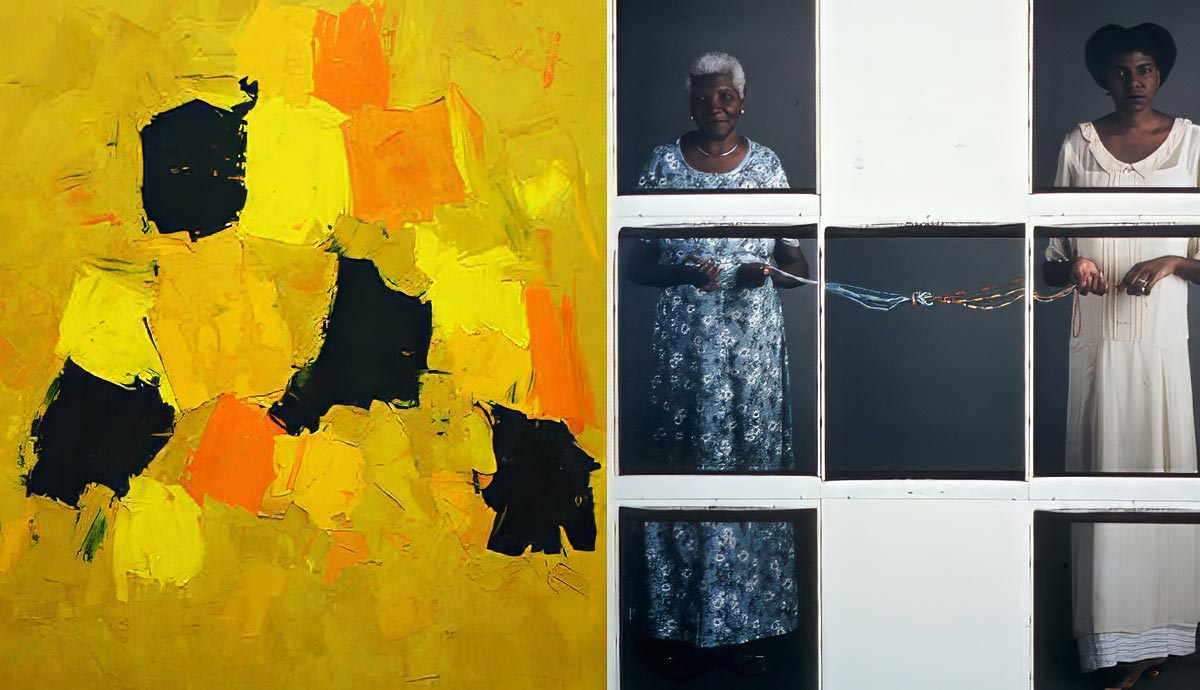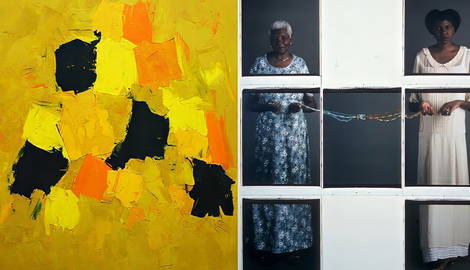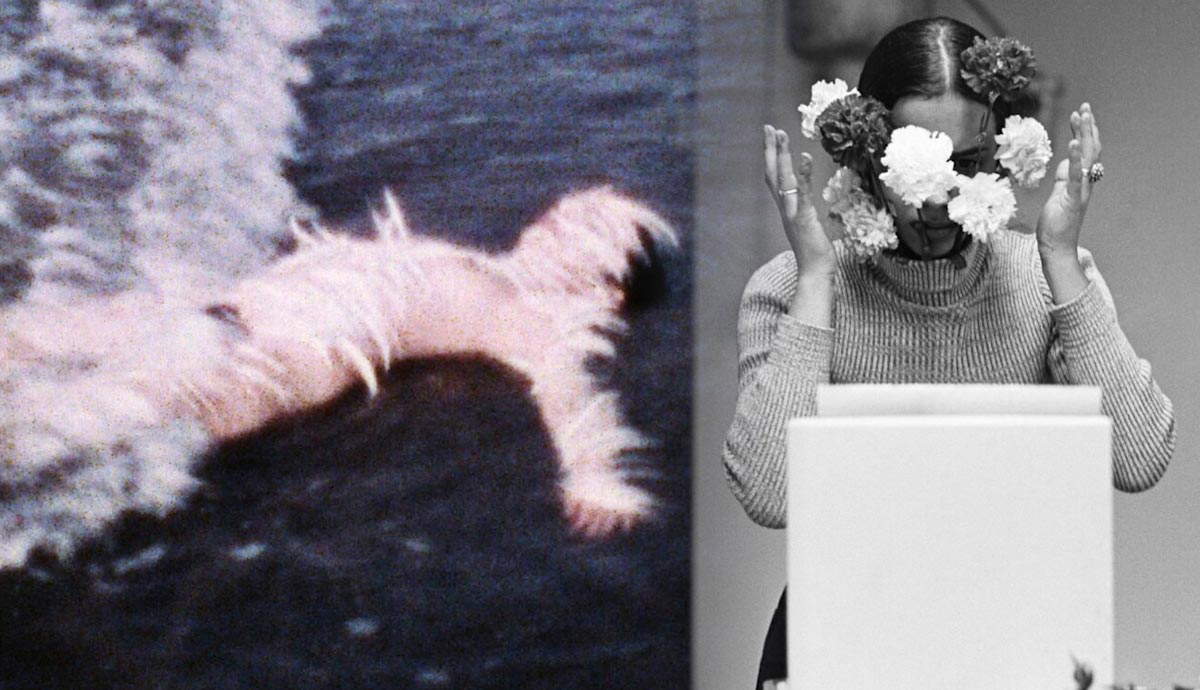
The works of the artists on this list tell a multi-faceted story of tradition, family, and endurance for both their art and cultures. These Hispanic artists come from different backgrounds and perspectives including Cuba, the United States, and Puerto Rico. Continue reading to learn more about the artists Carmen Lomas Garza, Ana Mendieta, Judy Baca, María Magdalena Campos-Pons, and Olga Albizu.
5. Carmen Lomas Garza

A constant motif in the works of Chicanna artist Carmen Lomas Garza is family. This is most notably seen in Garza’s pictorial paintings that depict the memories of her childhood growing up in Kingsville, Texas. From major family events such as La Feria en Reynosa to scenes of everyday life, her works focus on the strength and warmth of her family and community. These intimate portraits are extremely detailed as she incorporates imagery that specifically references familial scenes or objects.
There are many specific details in her works, like the piñata in The Birthdays of Lala and Tudi, a staple of children’s birthday parties, or nopal in Grandparents Picking Nopalitos. These help audiences who come from different backgrounds learn more about her culture. While a majority of her works focus on these themes, some subtly showcase the hardships that her community faced, particularly Mexican Americans in World War II.
In Earache Treatment her father is shown receiving treatment for his earache by her mother for an injury sustained during the war. In Cakewalk a fundraising activity thrown by the American GI Forum is shown. It is an example of how the community comes together.
Garza’s art is largely influenced by Mexican traditions, including paper cut-out designs inspired by papel picados, which she had learned to make as a child. Her designs feature symbols related to Mexican myths and traditions. They include symbols like eagles, rattlesnakes, or plants such as cactus and corn. These intricately cut-out designs have also been used to create larger artworks.
The designs are laser-cut into sheets of metal for large public murals including Baile, located at the San Francisco International Airport, or Welcoming which was commissioned by New Hope Housing, Inc. for a housing center for low-income residents. The artist has also created Ofrendas as part of her art installations. She has dedicated these to her grandfather, Antonio Lomas, the artist Frida Kahlo, and Tenochtitlan, the ancient Mexico City. She has created children’s books, including Family Pictures and Magic Windows which is about the craft of papel picados. She has also participated in art installations and public lectures in order to continue educating others about her heritage.
4. Ana Mendieta

Ana Mendieta made works representative of deeply rooted issues of femininity, displacement, and reconnection to the earth. At a young age, Mendieta was exiled from Cuba and, because of Operation Peter Pan, eventually relocated to an orphanage and various foster homes in Iowa until she was eventually reunited with her family. While studying and gaining her Master’s degree at the University of Iowa, Mendieta developed her methods of documenting her pieces through photography and film.
In one of her early works, the 1970s series Untitled (Glass on Body Imprints), Mendieta used panes of glass to press herself against in order to distort the photographed image. The actual making of her pieces, however, was about the traditions and cultures of Mesoamerica, including pre-Columbian artworks, Caribbean Santeria, and Mexican death rituals. References to the Goddesses of Cuban Taíno culture also played a key role in her works. For example, her short film Sweating Blood shows the use of these themes. She would also use organic materials with ritualistic practices as a way to connect back to her origins.
Mendieta is widely known for her Silueta series. The series was first created during a trip to Oaxaca, Mexico where she developed a practice of creating imprints of her body in the land or covering herself with organic materials. She documented these by taking pictures or filming videos, usually in solitude.
She continued to use materials from the natural world in other works as well. Her wooden slab and tree trunk sculptures contained gunpowder relief images. In her Amategrams series, she painted on amate bark paper made by the Otomi people of Mexico. Her imagery featured amorphous shapes with leaf-like or labyrinth-like patterns. Mendieta left records of some of her performances on paper too, like in the case of her Body Tracks series. In this piece, the artist used animal blood and tempera to leave imprints of her arms and hands on sheets of paper. She combined the rituals from her homeland of Cuba, with the techniques that she learned from the land she eventually relocated to. These works showcase the perspectives of an artist whose works remain relatable to people of different origins and backgrounds today.
3. Judy Baca

The works of Chicana artist Judy Baca showcase the histories and stories of the students and communities she has worked with as a professor at UCLA and as a community activist. Her activism led her to create the first Los Angeles mural program and co-found the Social and Public Art Resource Center (Sparc). One of her most recognized works is The Great Wall of Los Angeles (The History of California). The piece is 2,754 feet long which makes it one of the longest murals in the world. It depicts the stories of underrepresented communities covering their histories from ancient to modern times, and includes people from a multitude of backgrounds.
For public projects, Baca works with the people of these communities to gain their perspectives in order to create art that authentically represents them. She also tells stories relating to her personal history. The Memory of Our Land (2000) mural depicts the migration of Hispano-Mexicans and serves as a recollection of her ancestors and their descendants. Her murals combine traditional mural techniques with digital media and photography. This helps to further blend the past and present while adding futuristic elements together into pieces of visual history seen in works such as Seeing Through Others Eyes or Recollections (Durango).
Baca’s works also contain powerful imagery of women and their neglected societal roles. The mural Hitting the Wall: Women in the Marathon was made for the 1984 Olympics to depict the first time women were able to compete in the games. Uprising of the Mujeres and Mi Abuelita refer to neglected female voices and ancestors of the Indigenous population. In Mi Abuelita, the image of Baca’s grandmother, who had a major influence on the artist, was used as the basis for the mural. She shows different versions of how Latin women are perceived at various points throughout history.
In The Three Marias, Baca presented viewers with the choice between the 1940s and 1950s pachuca and the 1970s chola to showcase two very distinct archetypes of Chicana women. The mirror at the center of the piece literally lets viewers decide and question the relatability of these images in association with their own identity. Baca’s dedication to not only creating art but creating it with people from various backgrounds in her community is an important aspect of her career.
2. María Magdalena Campos-Pons

The many voices of artist María Magdalena Campos-Pons come together in a culmination of multi-media art pieces that are strongly tied with the cross-continental and cross-generational history of her family. In works like A Piece of Sea series and The Seven Powers Come by Sea, the artist pays homage to her ancestors from both Cuba and Nigeria and their journey across the ocean via the trans-Atlantic slave trade. In works such as Freedom Trap and Constellation, the braiding of hair is significant as it relates back to her familial history of enslavement, but it also refers to the beauty of the bonds made among the women of her family.
The matriarchal ties are important themes in her art. This can be seen in Replenishing and Spoken Softly with Mama which represent the strength and beauty that come from generations of women. This is also seen in the usage of African beads in Replenishing or the wooden carvings in her Untitled (Breast and Bottle Feeding) from her series When I am Not Here/Estoy Alla series.
The works of Campos-Pons incorporate specific plants and color choices that are tied to the practices and orishas (spirits) of Yoruba-derived Santería. Her film Baño Sagrado (Rite of Initiation – Sacred Bath), gives viewers a glimpse into her memories and serves as a continuation of her family’s practices and traditions.
Together, these works blend all of the familial ties of her ancestors and reflect the multifaceted identities of both the artist and her family. Born in Matanzas, Campos-Pons currently resides in the United States and has been creating art that combines her experiences of both places. This can be seen in the recent work Secrets of the Magnolia Tree which blends her perspectives of growing up in Cuba with living in the American South. She has also created a short film called When We Gather which features women artists from different backgrounds.
1. Olga Albizu

Olga Albizu is a prominent figure in the Abstract Expressionist movement. Born in Ponce, she is remembered and recognized as a founding member of Abstract Expressionism in Puerto Rico. She studied art in both Puerto Rico and New York and she developed a unique artistic language because of this.
Albizu’s works stand out from her New York contemporaries because of her uncompromising color combinations that produce enigmatic paintings. She is known for her use of thickly applied paints using a palette knife. Her grouping of various geometrical shapes in the center of the canvases can be seen in works like Red 103 or Yellow 873-94 Paintings like Untitled (Bodegon) and Green Self-Portrait take on less of a cube-like form and show the use of pastels by softly blending and layering the intense colors that she was known for.
Other works like Equilibrium show repetitions of swatches of intense hues instead of specifically placed blocks of color. Even though she predominantly used bold colors, paintings such as Tema Invernal II or Gris 9 feature a neutral color scheme of blacks and grays. For these works, Albizu’s use of textured brush strokes is more prominent and it showcases her skill and knowledge of blending color seamlessly.
Albizu’s works are often described as lyrical because of the rhythmic use of color placement. The artist also had strong ties with the world of music. Her mother was a pianist, and she grew up listening to classical music. She also worked as a secretary for the record labels Verve and RCA Victor and had a friend who displayed her paintings in the office. She had multiple paintings featured on the record jackets and album covers. These include covers of the albums Getz/Gilberto and Getz/Gilberto Vol. 2 by Saxophonist Stan Getz and Guitarist João Gilberto. Because of this, her artworks have been linked to Bossa Nova music. Her pieces have also been reproduced in other jazz and symphony orchestra rendition albums.










